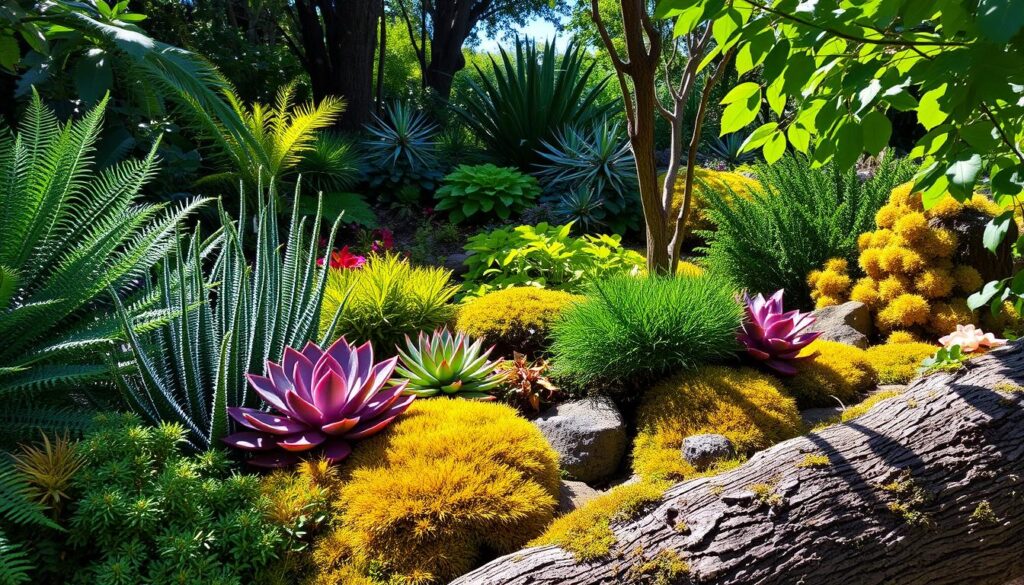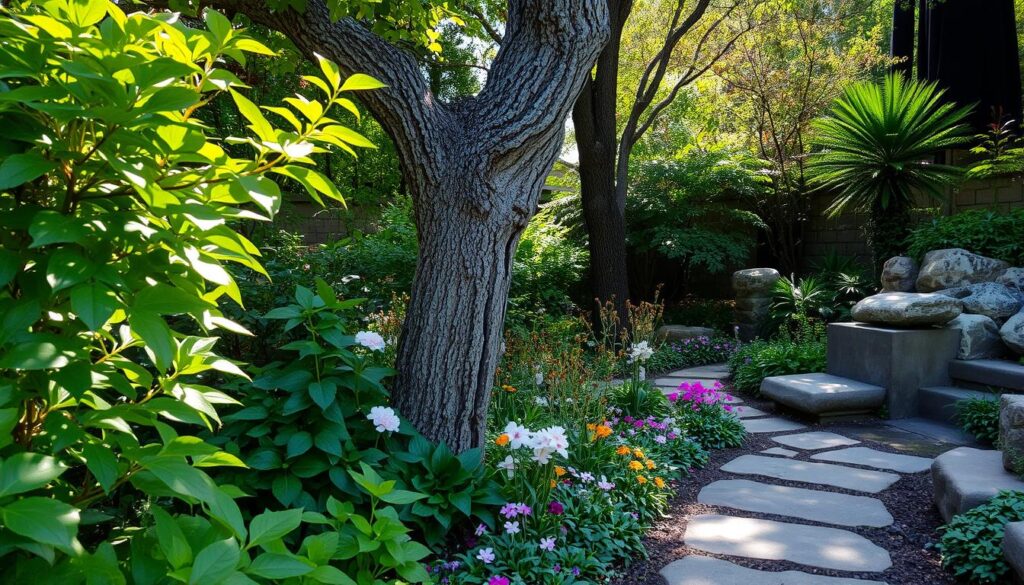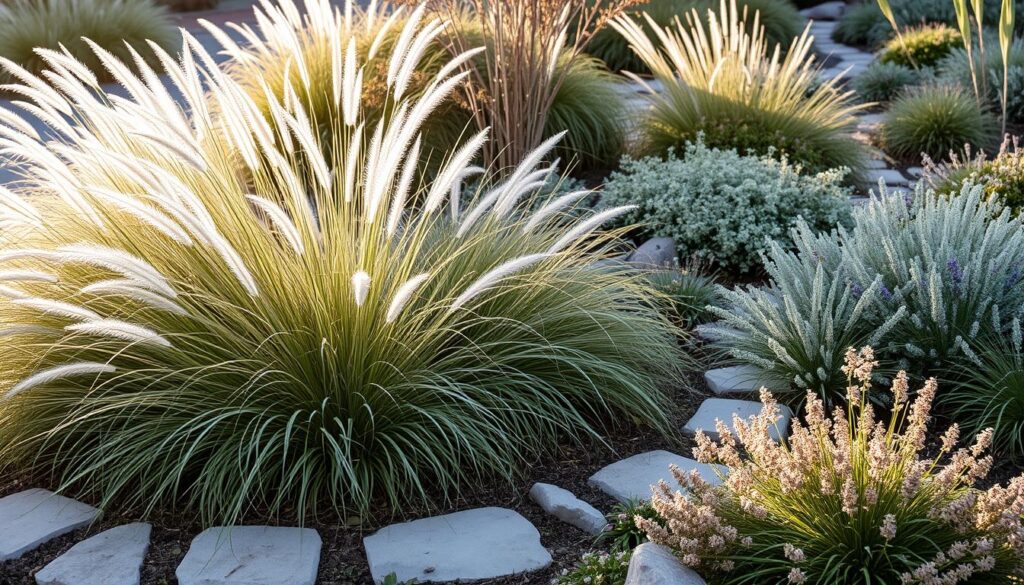
Landscape design in Prescott gardens gets exciting with plant textures. Choosing the right foliage can turn a plain yard into a stunning outdoor area. By mixing different leaf shapes and sizes, gardeners add depth and interest. This makes the garden eye-catching and intriguing.
In Prescott’s unique climate, texture is crucial for garden beauty. From the soft, feathery leaves of desert plants to the bold, spiky succulents, each texture brings its style. Together, these elements create a rich look that mirrors the local beauty.
Let’s dive into the world of plant textures and see how they can boost your Prescott garden. We’ll discuss how to mix textures for amazing landscape designs that suit our area. Get ready to see how texture can make your garden a masterpiece.
Key Takeaways
- Plant textures are vital for creating visual interest in Prescott gardens
- Diverse foliage enhances garden aesthetics and depth
- Texture selection should consider Prescott’s unique climate
- Combining textures can create stunning landscape designs
- Proper use of texture transforms simple yards into captivating spaces

Understanding Texture in Landscape Design
Texture is key in garden design. It brings depth and interest to Prescott’s landscaping. Let’s see how texture shapes our gardens and affects our visual experience.
Visual Texture vs. Tactile Texture
Visual texture is how a plant looks from far away. Smooth, shiny leaves look different from rough, matte ones. Tactile texture is what you feel when you touch a plant. Both types are important in garden design.
The Impact of Texture on Garden Aesthetics
Texture changes how we see space in a garden. Fine-textured plants make an area seem bigger. Coarse textures seem closer. Mixing textures adds visual interest and guides the eye through your landscape.
Texture as a Design Element in Prescott Gardens
In Prescott landscaping, texture is crucial for stunning gardens. The local climate supports many plant textures. From the soft, silvery leaves of native sages to the spiky texture of agaves, Prescott Gardens can show various textures. This adds depth and character to your outdoor space.
- Use fine textures to soften harsh lines
- Incorporate coarse textures for bold focal points
- Mix textures to create a visual rhythm
Understanding and using texture in your garden design can make a more engaging and visually appealing landscape. Texture is a powerful tool for Prescott gardeners. It lets you express your creativity and create unique outdoor spaces.
Plant Textures: A Key Component in Garden Composition
Garden composition in Prescott uses plant textures well. By mixing different textures, gardeners make their gardens interesting and deep. Textural contrast is key to a balanced and attractive landscape.
When picking plants, think about Prescott’s native plants. They have many textures you can use in your garden. Plants like sagebrush have soft leaves, while yucca has spikes, adding variety.

Mix plants with various leaf sizes and shapes to make your garden stand out. Combine smooth-leaved plants with rough or hairy ones. This mix catches the eye and adds depth to your garden beds.
- Smooth: Agave, Echeveria
- Rough: Artemisia, Lamb’s Ear
- Feathery: Mexican Feather Grass, Ferns
- Spiky: Sotol, Ocotillo
Plant textures change with the seasons. Some plants, like ornamental grasses, look good all year. Others are best in certain seasons. By choosing the right plants, your Prescott garden will look great all year.
Incorporating Coarse-Textured Plants in Prescott Landscapes
Coarse-textured plants bring bold looks and interest to Prescott gardens. They stand out and look great with finer plants.
Examples of Coarse-Textured Plants Suitable for Prescott
Here are some Prescott-friendly plants with unique textures:
- Agave: Thick, spiky leaves add structure all year
- Yucca: Tall, sword-like leaves make striking vertical lines
- Artichoke: Large, silvery leaves add a Mediterranean touch
- Russian Sage: Feathery, silver-gray foliage softens the look
Design Tips for Using Coarse Textures
Here’s how to use coarse-textured plants well:
- Use as focal points to draw the eye
- Pair with fine-textured plants for contrast
- Group in odd numbers for a natural look
- Consider mature size to avoid overcrowding
By thoughtfully adding coarse-textured plants, you’ll make a Prescott landscape that’s dynamic and pleasing to the eye. Engage in this thought-provoking article.
Fine-Textured Plants for Subtle Contrast

Fine-textured plants are key in Prescott garden design. They bring depth and subtle contrast with their delicate foliage. These plants have small leaves or needles, giving them a soft look that goes well with coarser elements.
Some fine-textured plants that do well in Prescott include:
- Ferns
- Ornamental grasses
- Baby’s breath
- Threadleaf coreopsis
To balance your garden’s texture, mix fine-textured plants with coarser ones. This mix adds visual interest and depth. Place delicate foliage near bold plants to show off their unique looks and soften rough edges.
Think about how fine-textured plants grow before you plant them. Some spread out a lot, while others stay compact. Use this info to plan your garden well, ensuring each plant has enough room.
Fine-textured plants are great for filling gaps between big plants and linking different garden areas. Their subtle beauty adds sophistication to Prescott gardens, making them a must-have for any thoughtful design.
Creating Balance with Medium-Textured Plants
Medium-textured plants are key to a balanced garden. They fill the space between coarse and fine textures. This makes your garden look unified.
Popular Medium-Textured Plants for Prescott Gardens
Prescott gardens do well with plants that fit the local climate. Some top picks are:
- Agastache
- Lavender
- Salvia
- Russian Sage
- Penstemon
These plants bring different textures of leaves and flowers. They add depth to your garden. They’re also great for adding interest all year round.
Blending Medium Textures with Coarse and Fine
Mixing medium-textured plants with coarse and fine ones creates balance. Use medium plants behind bold ones or to soften fine-textured areas. This mix makes your garden look good and balanced.
Try out different mixes to get the right balance for your garden. Medium-textured plants help make your garden welcoming and beautiful. They highlight the beauty of different plant textures.
Seasonal Variations in Plant Textures
In Prescott Gardens, the look of plants changes with the seasons. This creates a lively landscape. The Prescott climate is perfect for using different plants that look great all year.
As the weather changes, plants change how they look. This always makes the garden interesting to see.
Choose plants that look different in each season for year-round interest. Deciduous trees have smooth bark in winter but not in other seasons. Evergreens keep their needle-like look all year.
Grasses change from soft and flowing in summer to stiff and structural in fall and winter.
Adapt your garden to the seasons. In spring, please focus on the new leaves and their textures. Summer is perfect for plants with fine and coarse textures.
Fall shows off seed heads and changing leaves. Winter highlights the shapes of plants, like bark and dried leaves. Plan your garden this way to keep it interesting all year in Prescott.
Yavapai Landscaping Prescott offers complimentary estimates for Prescott and its nearby localities for landscaping and tree services, ranging from tree removal, trimming, stump grinding, land clearing, and storm cleanup to emergency tree care.
